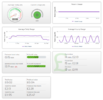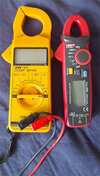- Joined
- 7 Jan 2010
- Messages
- 13,458
- Reaction score
- 3,359
- Country

Without mentioning smart meters, can anyone recommend a real time usage monitor for electricity? Easy to use/install (clamp on?) and preferably cheap. Thanks.


A wired one, seen ones where a sensor is clamped to the supply cable at the meter.Wifi display or at source
The electricity meter is not that precise.Your existing electricity meter.
Clamp on units are not fit for purpose as they don't take account of voltage variations or phase angle.

 not bad, but the non internet also gives power factor etc.
not bad, but the non internet also gives power factor etc.Really? I don’t believe it.The electricity meter is not that precise.

To try and see what energy is used at specific times, whether there is a certain peak load to see if solar panels are viable.but the first question has to be why?

 but they do not record time, so I can put it around the tails, and see by turning off all the RCBO's then turning them on one at a time what each circuit is using, but what does that tell me?
but they do not record time, so I can put it around the tails, and see by turning off all the RCBO's then turning them on one at a time what each circuit is using, but what does that tell me?Really? I don’t believe it.The electricity meter is not that precise.
When will you learn?Your existing electricity meter.
Clamp on units are not fit for purpose as they don't take account of voltage variations or phase angle.


I don't think the OP means that the Landis Gyr supplied by eon is incapable of accurately counting the kilowatt hours consumed by the house, more that it doesn't offer a fine enough resolution of how much was used in a specific period of time/use context, such as "on the cooker circuit, from 06:00 to 06:01 on 1st Dec 2022"Really? I don’t believe it.

Your voltage is unlikely to be 230v ever. Inaccuracy 1. No PF measurement. Inaccuracy 2.I have a current transformer on my supply leads hooked up to a Raspberry Pi PicoW.
It calculates the power drawn simply by amps*230V.
It also has an LDR which counts the 'flashes' from the electric meter (One flash = 1Wh used).
Well, it's interesting, especially as the PF isn't taken into account.
The readings from the CT correspond very well to the meter readings for purely resistive loads.
E.g. we switch on the kettle and both the CT & electric meter read an extra 3kW load.
Also makes sense and proves what I have said that a CT alone is not fit for purpose.But any kind of reactive loads, especially switched mode power supplies and the readings differ widely with the CT showing much higher readings. I'm guessing that includes all the LEDs in the house.
If you need to find a tradesperson to get your job done, please try our local search below, or if you are doing it yourself you can find suppliers local to you.
Select the supplier or trade you require, enter your location to begin your search.
Are you a trade or supplier? You can create your listing free at DIYnot Local
